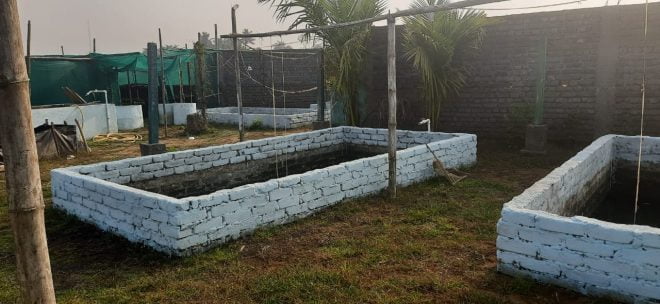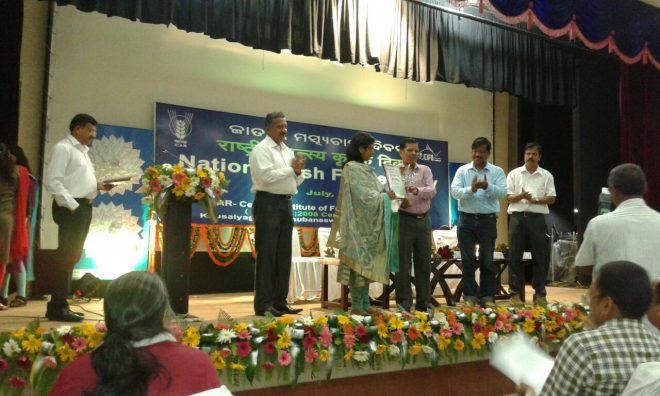Out Of The Ordinary: Former Bureaucrat Grows Pearls In Her Backyard At Odisha’s Balasore

If you thought growing pearls is a tough job, think again. Dr Nina Singh from Odisha’s Balasore district has shown the way and proved that these can be successfully cultivated in your backyard too!
Dr Singh has been cultivating pearls in her backyard for the last 7 years. Backed with a PhD in Zoology, and the confidence to start something new, she took the big leap to cultivate pearls in 2014.
Among the first few fresh water pearl farmers, Nina built two concrete water tanks in her backyard and started pearl cultivation at an investment of Rs 2 lakh.
“These pearls take at last 18 months to form and take shape. So, the first two years I was prepared for no profit as it was my experimenting time,” Nina told Odisha Bytes over phone while on a visit to her farm amidst the cyclone-induced rains in Balasore.
To gain more knowledge, she took training at ‘Freshwater Pearl Farming for Entrepreneurship Development’ at Central Institute of Freshwater Aquaculture (CIFA) in Bhubaneswar and a Kerala-based institute. However, it was only after doing it first-hand that she learnt minute details of fresh water pearl culture.

She says the main requisite for pearl farming is patience. “As it takes one-and-a-half years for a pearl to form and needs a lot of maintenance besides regular monitoring, patience is the key,” says Nina.
Well informed about the marine ecosystem, thanks to her educational background, Nina decided to add carp to the pearl culture tanks. She started carp fish breeding in the ponds in 2017 and says fish help in aeration and as they live in a symbiotic environment, they are helpful for clearing the nitrogenous waste thus helping in pearl formation in the mussels.

Nina now manages six ponds of 10×6 feet size from which her annual turnover is around Rs 10-15 lakh. The fish also contribute to her income.
What is a mussel and how are the pearls grown?
“The mussels (oysters) are kept in fresh water for 24 hours. After about two to three weeks, nucleus is inserted into them,” Nina explains.
However, Nina gives a design to the nucleus before inserting them, “I give shapes like Ganesha, flowers and animals to the nucleus inside the mould before inserting them into the mussels,” she adds.
The pearl mussels are generally caught from freshwater bodies and Nina sources them locally.
Once the insertion is over, the mussels are kept in fruit trays which float at a height of 3 feet inside the pond. The first job done, a one-year wait begins. Then nucleus takes the shape of a pearl sac collecting calcium carbonate from the mussel shell. The long journey ends and the mussels are carefully opened to take out the designer pearls.
“The mussels act as a natural purifier for the fish waste. When the fish excreta starts decomposing, the plankton absorbs it. The plankton is eaten by the mussels. I also apply lime in the pond to increase productivity and boost a more healthy environment,” adds Nina.
The former Odisha Administrative Officer grows 10,000 pearls in one cycle. The pearls harvested in Nina’s farm are procured by traders in Mumbai, Rajasthan and Delhi.
“I initially tried to sell the produce locally but people did not really show any interest and then I started exploring options,” she adds.
She markets her products through her startup Tisya Agri Venture and trains farmers from Rajasthan and Uttar Pradesh. She had 400 farmers, pre-COVID. The business which had become dull during COVID is gradually picking up after the venues opened.
Nina has been felicitated by CIFA and honoured with the Prof. MC Nandeesha Farmer’s Innovation Award by Asian Fisheries Society, Indian Branch for popularising pearl farming.

Pond care
A pH in the range of 7 to 8 is favourable because pearl mussels require more calcium for the secretion of nacre.
Water temperature is also an important factor in the mussels’ growth and reproduction, and the process of pearl formation in mussels’ body cavities requires a temperature in the range of 25-30°C.
Management of water quality, through liming or fertilization, is important as it affects the quality and quantity of pearls.
Algal culture facilities in the mussel farm are a must. The baskets or bags in which the implanted mussels are kept should be cleaned fortnightly.

Comments are closed.